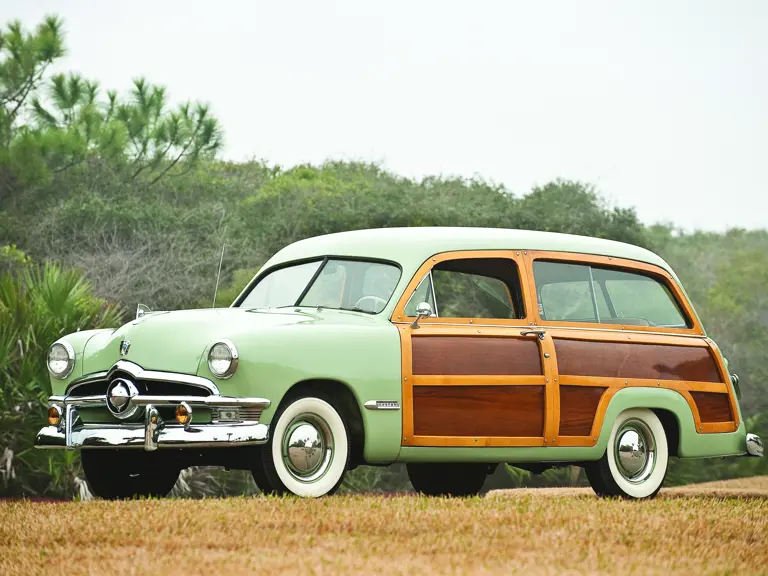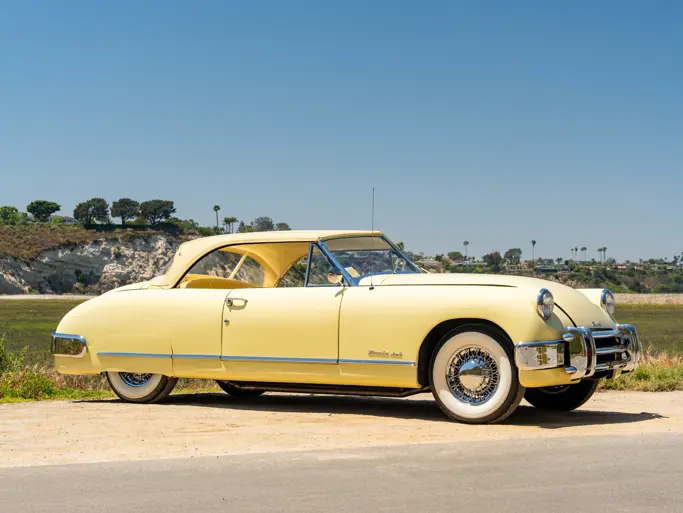
1950 Ford Custom Deluxe V-8
{{lr.item.text}}
$60,500 USD | Sold
{{bidding.lot.reserveStatusFormatted}}
- 239-cid, 100-hp flathead V-8 engine
- Beautifully restored
- From prominent, well-tended collection
- AACA National First Prize winner (Jr. & Sr.)
- Multiple-time Ford V-8 Club Dearborn Award winner
- Quite uncommon
- Late model example with new-for-mid-year steel tailgate
- Popular "woodie" would be welcome at many events
Handsome enough to be welcomed at any venue, then or now, it’s hard to imagine that anything so good looking could also be so useful. With the 1950 Ford Custom Deluxe Station Wagon, you can transport up to eight people in style and comfort …or tote you and friends to the golf club or beach with ease since it has up to a half-ton capacity.
Ford’s all-new 1949 models were a big hit, but station wagons posed a challenge. For many years Ford, affectionately referred to as the nation’s “wagonmaster,” was comfortable in out-producing all competing manufacturers of station wagons. From the 1940 models through the 1948 models, the wagon bodies had been made in Ford plants in upper Michigan, with wood from Ford-owned forests. However, traditional wagon bodies would not work with the new cars’ lines, plus the fact that the competition was phasing out wood altogether.
Ford had great recognition in the wood art form and was reluctant to go all-steel. A steel skeleton body was designed and skinned with mahogany plywood, framed in maple or birch. Laminating and heat-bonding techniques learned during the war while building gliders for the armed forces led to curved wood laminates. This construction not only allowed complex wood shapes, it reduced waste and was less costly. Only two-door station wagons were built, and the Ford wagon came only in upscale custom trim, called “Custom Deluxe” in sales literature.
For 1950, Ford station wagons had real leather only on the driver’s seat (second and third seats were in vinyl) and received the automatic courtesy light, now standard on Custom Deluxe models. Besides the offering of the Six series and the V-8 series, there were two versions of the station wagon in 1950. The early model carried over the window design, seats and wood tailgate of the 1949 Custom.
In May 1950, to keep pace with competitors’ new developments, a revised model was introduced. The second seat could be folded flat for load space and with the tailgate being able to now being laid flat, it could now accommodate 4- x 8-foot sheets and proved to be a valuable sales point. The third seat still had to be removed, but you had choices in configuration to best suit your current needs.
The side windows were changed so that only the forward pane slid open, and a steel stamping replaced the wood tailgate. The car being offered carries the later steel tailgate. The side panels, too, were now steel, with Di-Noc imitation woodgrain. Although the name did not appear on the cars, the new Ford wagons received a new title for the later model year cars, “Country Squire,” which was used in various print ads and dealer folders of the period and would go on to become one of the most recognized names in American station wagons.
Ford offered six different body styles in the Custom Deluxe V-8 series with a total series output of 816,371 cars. The station wagon was also available with the six-cylinder engine; Ford did not break down how many received the six or the eight, but 29,017 Custom Deluxe Station Wagons were produced – only 3.5-percent of the total.
Currently owned and displayed in a prestigious Florida collection, this exceptionally restored early Ford “Country Squire” is an AACA National First Prize (Junior and Senior) winner, well maintained professionally and resides in a climate controlled setting. It is hard to not be immediately drawn to the lush beauty of the wood body elements that are set-off by the rich tone of Palisade Green. Powered by the venerable 239-cid, 100-hp flathead V-8 engine, we were not informed (nor can it be determined conclusively in photos) if this car has the standard three-speed manual transmission or optional automatic.
What is certain is that the spare is stylishly carried and presented on the tailgate, Continental-style, in a matching painted cover, Ford foglights adorn the front bumper, wood-like interior door panels, two-tone seats, Custom badging, AM radio, heater/defroster, seatbelts (added), Ford chromed exhaust tip, color-keyed steel wheels with factory center caps and trim rings, bumper guards, a distinctive grille and Firestone Deluxe Champion wide whitewall tires for that “just-right” period look. The gorgeous hood ornament was a new design for 1950 and gives a smart touch of distinction to the Ford’s broad, sweeping hood lines.
Along with the respected AACA awards, this Ford wagon is a multiple-time Early Ford V-8 Club of America Dearborn Award winner. At the last (unspecified date) Ford V-8 Club national meet that it participated in, the owner conveys that the car scored a very impressive 985 points of the 1,000 available.
Advertised in period to be ready “for Monday’s hauling….or Sunday’s calling,” this 1950 Ford “Country Squire” wagon is still on-call to perform double-duty. Part of the famous “Woodie” heritage, it obviously is ready to be shown and enjoyed at many types of meetings or you will be able to proudly present yourself, family and friends wherever you want to be seen and remembered.


 | Fort Lauderdale, Florida
| Fort Lauderdale, Florida


